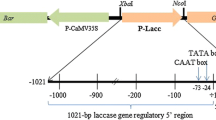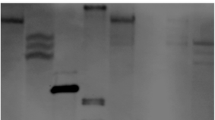Abstract
Transcriptionally regulated expression of tobacco anionic peroxidase was investigated with regard to tissue specificity and developmental regulation. Two tobacco species, Nicotiana sylvestris and Nicotiana tabacum cv. Xanthi, were stably transformed with a gene chimera composed of 3 kb of the tobacco anionic peroxidase promoter, the Escherichia coli β-glucuronidase (GUS) coding region and the nopaline synthase terminator. Gene expression was regulated spatially and developmentally in all organs, and generally increased with age and maturity of the plant, tissue or organ. In the aerial portions of the plant, GUS activity was strongly expressed in trichomes and epidermis at nearly all developmental stages. In later stages of development, activity was also detected in ground tissue and parenchyma cells associated with vascular tissues. Activity in roots was limited to cortical cells and vascular-associated parenchyma cells. In reproductive tissue, expression was observed in sepals and petals before anthesis, and in all floral organs after anthesis. Expression was never detected in vascular tissue and was poorly correlated with lignification except in the cells surrounding primary xylem and pericyclic fibers in N. sylvestris. These studies suggest that this peroxidase isoenzyme is only limitedly involved in lignification but may be important in plant defense, growth and development.
Similar content being viewed by others
References
Bradford M: A rapid and sensitive method for the quantification of microgram quantities of protein utilizing the principle of protein-dye binding. Anal Biochem 72: 248–254 (1976).
Campa A: Biological roles of plant peroxidases: known and potential function. In: Everse J, Everse KE, Grisham MB (eds) Peroxidases in Chemistry and Biology, vol. 2, pp. 25–50. CRC Press, Boca Raton, FL (1991).
Chung CT, Niemaela SL, Miller RH: One-step preparation of competent Escherichia coli: transformation and storage of bacterial cell in the same solution. Proc Natl Acad Sci USA 86: 2172–2175 (1989).
Diaz-De-Leon F, Klotz K, Lagrimini LM: Nucleotide sequence of the tobacco anionic peroxidase gene. Plant Physiol 101: 1117–1118 (1993).
Dowd PF, Lagrimini LM: The role of peroxidase in host insect defenses. In Carozzi N, Koziel M (eds) Transgenic Plants for Control of Insect Pests, pp. 195–223. Taylor and Francis, New York (1997).
Esau K: Anatomy of Seed Plants, 2nd ed. John Wiley, New York (1977).
Felton GW, Donato K, DelVecchio RJ, Duffey SS: Activation of plant foliar oxidases by insect feeding reduces nutritive quality of foliage for noctuid herbivores. J Chem Ecol 15: 2667–2694 (1989).
Fry S: The Growing Plant Cell Wall: Chemical and Metabolic Analysis. Longman Scientific and Technical, Essex (1988).
Gallagher S (ed): GUS Protocols: Using the GUS Gene as a Reporter of Gene Expression. Academic Press, San Diego, CA (1992).
Gazaryan I, Lagrimini LM: Tobacco anionic peroxidase overexpressed in transgenic plants. II. Aerobic oxidation of indole-3-acetic acid. Phytochemistry 42: 1271–1280 (1996).
Harris P, Hartley R: Detection of bound ferulic acid in cell walls of the Gramineae by ultraviolet fluorescence microscopy. Nature 259: 508–510 (1976).
Hinnman R, Lang J: Peroxidase catalyzed oxidation of indole-3-acetic acid. Biochemistry 4: 144–158 (1965).
Intapruk C, Yamamoto K, Sekine M, Takano M, Shinmyo A: Regulatory sequences involved in the peroxidase gene expression in Arabidopsis thaliana. Plant Cell Rep 13: 123–129 (1994).
Jefferson RA: Assaying chimeric genes in plants: the GUS fusion system. Plant Mol Biol Rep 5: 387–405 (1987).
Jefferson R, Kavanagh T, Bevan M: GUS fusions: β-glucuronidase as a sensitive and versatile gene fusion marker in higher plants. EMBO J 6: 3901–3907 (1987).
Jensen W: Botanical Histochemistry: Principles and Practice, p. 205. Freeman & Co., San Francisco (1962).
Klotz K, Lagrimini LM: Phytohormone control of the tobacco anionic peroxidase promoter. Plant Mol Biol 31: 565–573 (1996).
Lagrimini LM: Altered phenotypes in plants transformed with chimeric tobacco peroxidase genes. In: Penel C, Gaspar T, Lobarowski J (eds) Molecular and Physiological Aspects of Plant Peroxidases, pp. 128–140. University of Geneva Press, Geneva (1991).
Lagrimini LM: Wound-induced deposition of polyphenols in transgenic plants over-expressing peroxidase. Plant Physiol 96: 577–583 (1991).
Lagrimini LM, Bradford S, Rothstein S: Peroxidase-induced wilting in transgenic tobacco plants. Plant Cell 2: 7–18 (1990).
Lagrimini LM, Burkhart W, Moyer M, Rothstein S: Molecular cloning of complementary DNA encoding the ligninforming peroxidase from tobacco: molecular analysis and tissue-specific expression. Proc Natl Acad Sci USA 84: 7542–7546 (1987).
Lagrimini LM, Rothstein S: Tissue specificity of tobacco peroxidase isozymes and their induction by wounding and tobacco mosaic virus infection. Plant Physiol 84: 438–442 (1987).
Lagrimini LM, Vaughn J, Erb W, Miller S: Peroxidase overproduction in transgenic tomato plants: Analysis of woundinduced polyphenol deposition and disease resistance. HortScience 28: 218–221 (1993).
Lam E, Chua N-H: ASF-2: a factor that binds to the cauliflower mosaic virus 35S promoter and a conserved GATA motif in Cab promoters. Plant Cell 1: 1147–1156 (1989).
Liu L, Dean J, Friedman W, Eriksson K-E: A laccase-like phenoloxidase is correlated with lignin biosynthesis in Zinnia elegans stem tissues. Plant J 6: 213–224 (1994).
Levin DA: The role of trichomes in plant defense. Quart Rev Biol 48: 3–15 (1973).
MacAdam JW, Nelson CJ, Sharp RE: Peroxidase activity in the leaf elongation zone of tall fescue. I. Spatial distribution of ionically bound peroxidase activity in genotypes differing in length of the elongation zone. Plant Physiol 99: 872–878 (1992).
Mäder M, Füssl R: Role of peroxidase in lignification of tobacco cells. II. Regulation by phenolic compounds. Plant Physiol 70: 1132–1134 (1982).
Mäder M, Meyer Y, Bopp M: Localization of peroxidase isozymes in protoplasts and cell walls of Nicotiana tabacum L. Planta 122: 259–268 (1975).
Mäder M, Nessel A, Bopp M: On the physiological significance of the isozyme groups of peroxidase from tobacco demonstrated by biochemical properties. II. pH optima, Michaelisconstants, maximal oxidation rates. Z Pflanzenphysiol 82: 247–260 (1977).
Moerschbacher BM: Plant peroxidases: Involvement in response to pathogens. In: Penel C, Gaspar T, Greppin H (eds) Plant Peroxidases 1980–1990: Topics and Detailed Literature on Molecular, Biochemical, and Physiological Aspects, pp. 91–99. University of Geneva, Geneva (1992).
Mohan R, Vijayan P, Kolattukudy PE: Developmental and tissue-specific expression of a tomato anionic peroxidase (tap1) gene by a minimal promoter, with wound and pathogen induction by an additional 5′-flanking region. Plant Mol Biol 22: 475–490 (1993).
Okamuro JK, Goldberg R: Tobacco single-copy DNA is highly homologous to sequences present in the genomes of its diploid progenitors. Mol Gen Genet 198: 290–298 (1985).
Roberts E, Kutchan T, Kolattukudy PE: Cloning and sequencing of cDNA for a highly anionic peroxidase from potato and the induction of its mRNA in suberizing potato tubers and tomato fruits. Plant Mol Biol 11: 15–26 (1988).
Rothstein S, Lahners K, Lotstein R, Carozzi N, Jayne S, Rice D: Promoter cassettes, antibiotic-resistant genes, and vectors for plant transformation. Gene 53: 153–161 (1987).
Simon R, Priefer U, Puhler A: Vector plasmids for in vivo and in vitro manipulation of gram-negative bacteria. In: Puhler A (ed) Genetics of the Bacteria-Plant Interaction, pp. 98–106. Springer-Verlag, Berlin (1983).
Uknes S, Dincher S, Friedrich L, Negrotto D, Williams S, Thompson-Taylor H, Potter S, Ward E, Ryals J: Regulation of pathogenesis-related protein-1a gene expression in tobacco. Plant Cell 5: 159–169 (1993).
Welinder KG: Superfamily of plant, fungal, and bacterial peroxidases. Curr Opin Struct Biol 2: 388–393 (1992).
Williams M, Foster R, Chua N-H: Sequences flanking the hexameric G-box core CACGTG affect the specificity of protein binding. Plant Cell 4: 485–496 (1992).
Ye X, Pan S, Kuc J: Activity, isozyme pattern, and cellular localization of peroxidase as related to systemic resistance of tobacco to blue mold (Peronospora tabacina) and to tobacco mosaic virus. Phytopathology 80: 1295–1298 (1990).
Author information
Authors and Affiliations
Rights and permissions
About this article
Cite this article
Klotz, K.L., Liu, TT.Y., Liu, L. et al. Expression of the tobacco anionic peroxidase gene is tissue-specific and developmentally regulated. Plant Mol Biol 36, 509–520 (1998). https://doi.org/10.1023/A:1005939600344
Issue Date:
DOI: https://doi.org/10.1023/A:1005939600344




